by Wine Owners
Posted on 2019-03-25
The basic premise for investing in fine wine is a very simple one; you buy a truly great wine that is produced in a finite quantity and store it, carefully. So, whilst others are enjoying/drinking theirs, thereby reducing the supply of that wine, you enjoy the price appreciation that naturally results from the increased rarity value. The growth in global wealth and newly discovered riches help fuel the desire for these wines for added benefit. For example, Chateau Latour 1982 was released in 1983 at c. £400 per case of 12 bottles. That case could today be sold for £16,000, implying an annual growth rate of a little over 12% per annum over the course of its life (and it will continue to be enjoyable for another 50+ years).
So, it is easy then?
First a bit of background.
The investment market is dominated by the red wines of Bordeaux where production levels of top-quality wine far exceeds any other area of note. Other areas which spark interest include the finest wines of Burgundy, Champagne, Tuscany and Piedmont and to a lesser extent some of the trophy wines from the new world.
For decades, centuries even, ‘gentlemen’ have been investing in wine, maybe unintentionally, but certainly filling their cellars with good Bordeaux and Burgundy, Port and Madeira and the like. Auction houses commenced wine sales in England in the middle of the last century and now there are all manner of brokers, merchants, exchanges and on-line auctions in existence. The internet has lent transparency to what was an opaque market, brought an endless flow of information and with it various offerings from a wide range of ‘investment specialists’. Investing in wine has become a more commonplace activity. Very few of these specialists, however, are authorised by the FCA or an equivalent and, thanks to the great bull market of 2005-2011 a proliferation of new companies designed to take advantage of this phenomenon were formed.
Like all markets the wine market continues to evolve although the last decade has proved to be probably the most turbulent period in its history. Previously, wine price performance was generally very steady with long term returns going back to the seventies averaging just over double figures. Once a decade or so, a global crisis would cause a healthy reality check (the oil crisis of ’73, the stock market crash of ’87, the Asian currency crisis of ’97 and the Lehman debacle of ’08, although the latter turned out to be very short lived) and then things would revert to normal.
The great bull run that begun in 2005 was created by exceedingly high and new demand emanating from mainland China. The fast expanding Chinese economy created easy money that flowed through the hands of the relatively experienced Hong Kong based merchants all the way to London, the global centre of secondary market wine trading (the primary markets being located at the point of production). Prices were pushed higher and higher, no one wanted to sell as the value kept on going up, until one day it all stopped.
What had not been appreciated at the time, by either the market or its participants was that this money was not just coming from the newly wealthy and aspirational individual but mainly from officials and employees of state owned enterprises.
Their ostentatious extravagance was legendary – lavish dining in top class restaurants and hotels accompanied by lashings of fine first growth wines, the corporate gifting of wine that oiled the wheels of business and the need to be seen only drinking the very best.
The government had lost control – and that was not going to wash with the incoming new President, Xi Jinping. In mid-2011 all luxury items and their markets were knocked back as the new environment of anti-graft measures were introduced and these measures remain firmly in place today. Having risen c. 260% from ’05 to mid-2011, the Liv-ex 100 index, the leading market indicator, then fell by 36% between mid-2011 and mid-2014. Since then the market has stabilised and in recent weeks has started to appreciate once again. The natural order is returning, and the madness of this extraordinary period has receded, the river of cash from China has dried up and a lot of the new, often dubious, players have been washed up on that river’s banks.
Another major factor that came into play during this period of flux was the stratospheric pricing of two Bordeaux vintages of outstanding quality, 2009 and 2010. Not wishing to miss the party the Bordelais lost their heads; 2009 sold but the market just couldn’t stomach the prices from 2010. Subsequent vintages were not reduced to commercial levels and have also failed to sell.
Some readers will be familiar with en primeur, meaning the first release, which is the first opportunity to purchase wine from the new vintage. In the good old days this was the opportunity to get in on the ground floor and the majority of investors and consumers benefitted. That game is long gone and arguably the market has split between the recent vintages where the release price still influences and the older vintages where the secondary market controls pricing. The market for older wines is, in any case, more compelling as pricing is more logical, there is greater assurance of quality and the dwindling of supply has begun.
Opportunities abound, especially now we are ‘ex-China’. Pricing has never been more competitive and the information available have never been so sophisticated. So, yes, it is easy – if you know what you are doing!
Miles Davis, February 2015
by Wine Owners
Posted on 2019-03-21
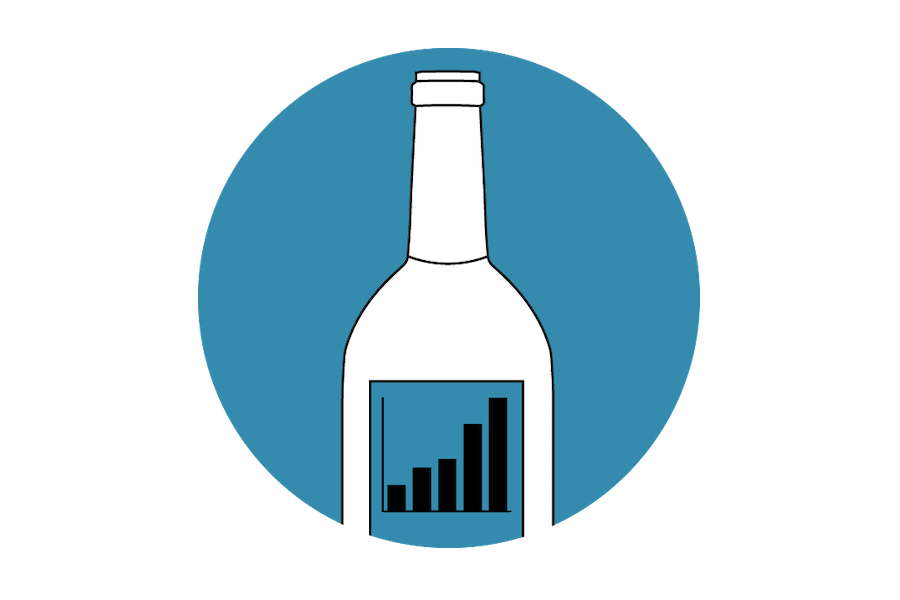
The Wine Owners platform is rich in data and content.
Pricing
Our proprietary algorithms process millions of rows of incoming pricing data to calculate a Market Level - the price at which a wine is likely to find a ready buyer - based on market supply and spread models. The more liquid the wine the more accurate the price will be. Small production wines from older vintages can be virtually impossible to value and although we try our utmost to find a reference point, sometimes it just isn’t possible. This is hardly a new phenomenon for the wine market.
Scores
The Wine Owners average score is the Mean of all scores analysed for a wine that are published by wine writers and critics. For details of the main wine writers' scores that feed into the Wine Owners average mean score, please see the page on wine critics.
The WO average comes in on the conservative side (think Burghound not Parker), so anything above a 95 is a brilliant score.
Research and analysis
If you subscribe to the Collector package (for privates) or the Professional package (for trade) it is possible to research present and historic pricing, produce charts and carry out your own relative value analysis. You will be able to build your own vertical and horizontal analysis using Market Price versus Score and Relative Value Score and/or compare different wines from different vintages on the same chart, some examples here:
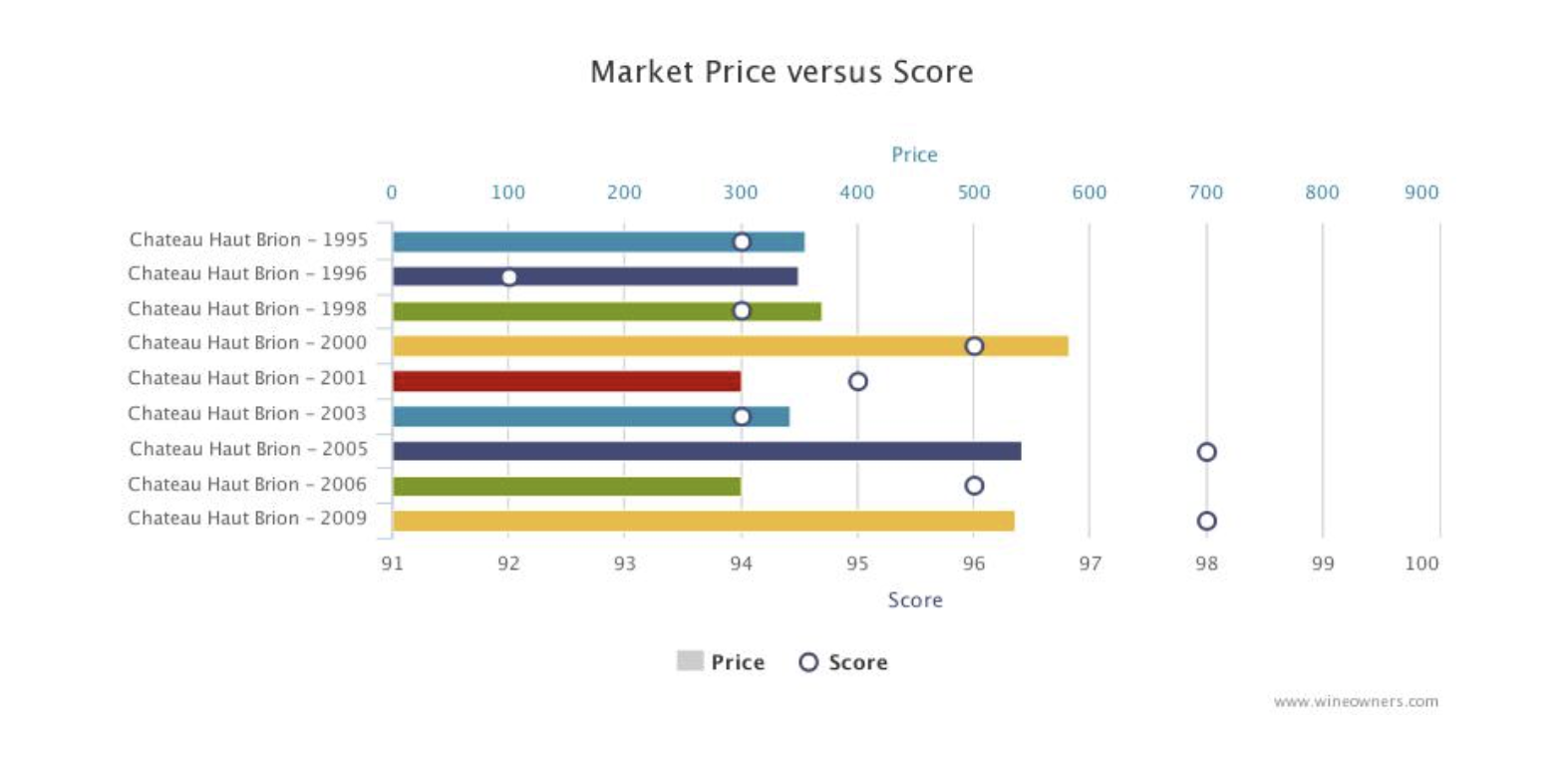
The above chart is self-explanatory, the below less so. The Relative Value Score equation is this:
(WO score - 79) * (WO score - 79) * 10 / price
By using this tool, you soon become used to identifying ‘cheap’ opportunities. Any First Growth that registers a double digit score looks good (but will always need further scrutinization), a highly rated super second from a good vintage scoring 20 looks interesting.
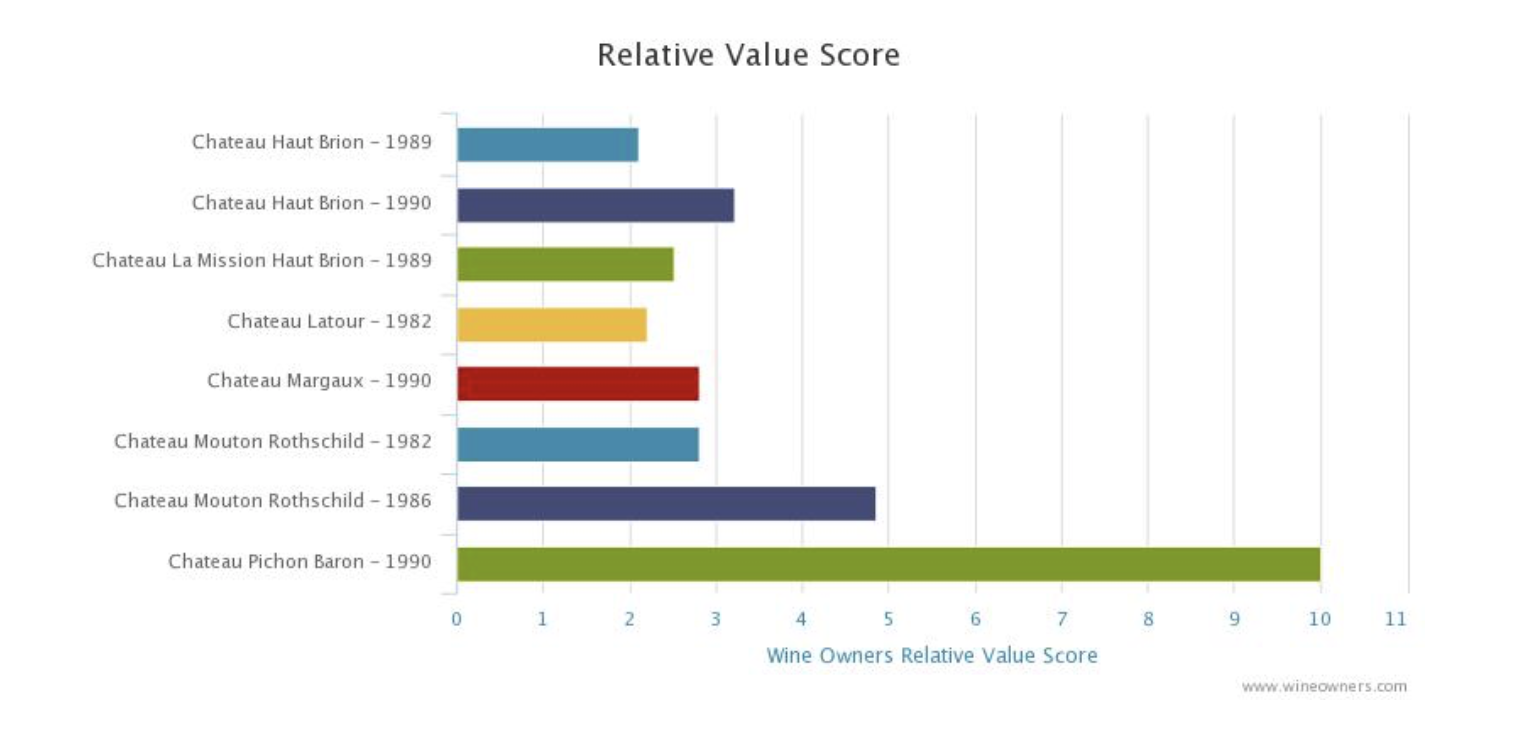
Graphs
Generate your own fully customised graphs. Compare wine against wine(s), against wine indices and financial indices too!
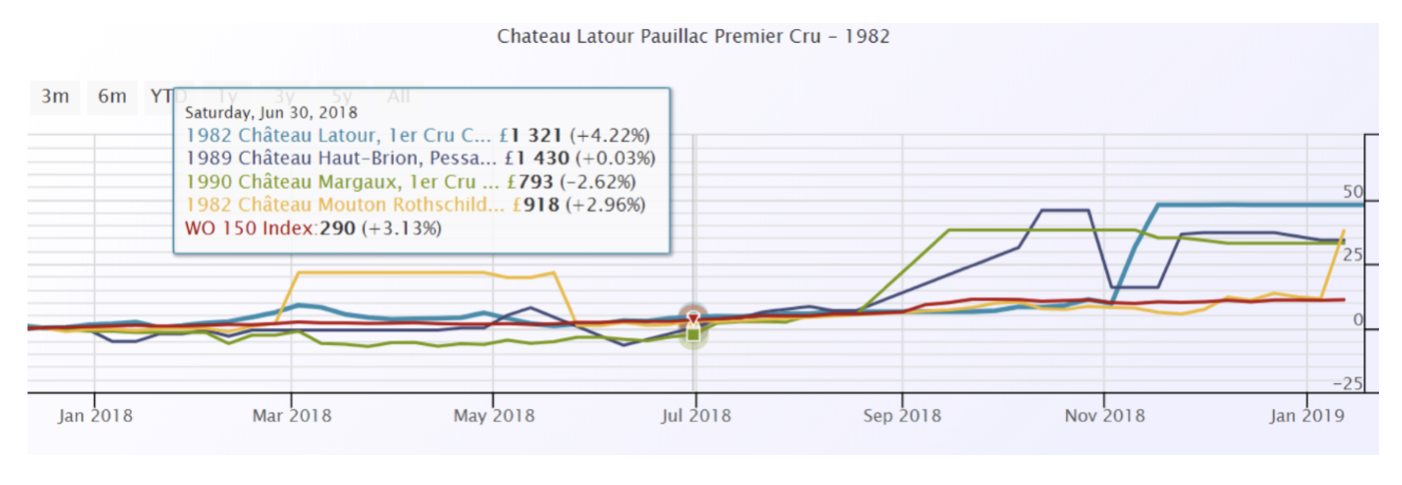
by Wine Owners
Posted on 2019-03-14
2007 £1,300 per 6 WO Score 96
2010 £2,100 per 6 WO Score 100
Bartolo Mascarello is one of the true legends of Barolo, think Rousseau or Roumier in Burgundy terms, in case you’re not familiar with the ‘Knights of Nebbiolo’. And if that’s still confusing, think Liverpool (Football Club), but I would say that, wouldn’t I? In fact, to be drawn against Juve tomorrow morning could easily inspire a trip to Piedmont, with a bit more than hazelnuts to look forward to! I digress…
Maria-Teresa Mascarello took over from Bartolo, her father, in 1993, the estate having been founded in 1918. Beautifully simple in its creation, the wine is a blend of four of the top crus, or vineyards and has been consistently and spectacularly successful for decades.
In the charts above and below we have compared various well-regarded vintages of a similar era. These vintages are very good and very scarce, two of the most important factors for investors as they are squirreled away by the canniest collectors and prices have been rising. They are still a fraction of their Burgundian cousins however and we have no issue with recommending a buy, particularly the ’07 and the ’10, the cheapest relative value bets here:
Tasting notes, courtesy of Vinous Media:
2007: Mascarello’s 2007 Barolo shows just how compelling this vintage can be, even now. Sensual, layered and totally voluptuous in the glass, the 2007 shows the more flamboyant side of Barolo. I find the wine’s voluptuous, engaging personality impossible to resist. Sure, 2007 is not a classic vintage, but when a wine is this good, I say: Who cares?
2010: The 2010 Barolo is one of the most striking, hauntingly beautiful wines I have ever tasted here. Mysterious and slow to show its cards, the 2010 impresses for its inner perfume, sweetness and exceptional overall balance. Today the striking fruit and classic, austere elements of the vintage take turns in dominating the wine's balance. The 2010 was always magnificent in barrel. It is equally spectacular from bottle. Readers who can find the 2010 should not hesitate. Ideally I wouldn't dream of touching a bottle until age 15 or so, although I doubt I will personally have the discipline to follow my own advice!
The 2007 is the cheaper option from a classic vintage and the 2010 is the turbo charge version from the all-conquering 2010 vintage. Both are recommended.
by Wine Owners
Posted on 2019-03-07
February was a relatively quiet month for the wine market. The month started with the Chinese New Year celebrations which meant Asia was quiet and it also contained a European half term break. Sentiment towards Brexit turned, meaning GBP strengthened towards the end of the month, which is never good for the wine market as US$ based bids (U.S. and Asia) automatically adjust downwards. The broad base WO 150 index fell by 2.4%, as did our Blue Chip Burgundy index. In fact, all the indices for the major wine producing regions came off by c.3%.
If recent discussions with the finance and new venture folk surrounding wine as an alternative asset class were anything to go by, this is beginning to look like a good time to buy. Following the Brexit inspired rise of USD and Euro against GBP in 2016, the Bordeaux market has done nothing for almost a decade. ‘Bordeaux bashing’ peaked years ago too - just resentful shrugging goes on these days! En primeur looms but is largely a dead duck, so that is unlikely to provide stimulus to the market but a wall of money certainly might do the trick… watch this space!
We were busy trading 2009 red Bordeaux following various reports published after ‘ten year on tastings’. We blogged about these in general and focussed on one wine separately, Cos d’Estournel. We concluded that, as it continues to split opinion, and received some pretty low scores (93 from Jane Anson of Decanter for example), coupled with challenging price levels why take the risk when there are so many less controversial and comparatively cheaper wines available? There are many names still available on the exchange, from the excellent Cantemerle at c.£300 to Haut Brion and Mouton Rothschild at the cheapest in the market prices.
If you’re looking for decent ‘drinking’ claret buying en primeur made very little sense even back in 2009 which blew apart every previous record ever held for wine sales, anywhere on the planet. Factoring in the cost of storage and capital and the effect of inflation, the very respectable names of Cantemerle, Capbern Gasqueton, Haut Bergey, Lafon Rochet, Ormes de Pez and Potensac are all better value today than they were then! All these names are available on the platform today.
Sassicaia was in focus with the release of the much admired 2016 vintage, Monica Larner of the Wine Advocate awarding the full 100 points and meaning Armit, the UK agent sold out in seconds.
Screaming Eagle ’16 was released and is now offered at £7,250 per 3 bottles in the U.K. market. Not altogether surprisingly, this is making some older vintages looking relatively cheap! The ’17 will not be sold under the usual label due to smoke taint from the Californian wildfires.
And finally, we learnt the sad news that Gianfranco Soldera passed away in the middle of the month. We are planning to honour the magician of Montalcino with a memorial dinner later in the year, possibly in May.
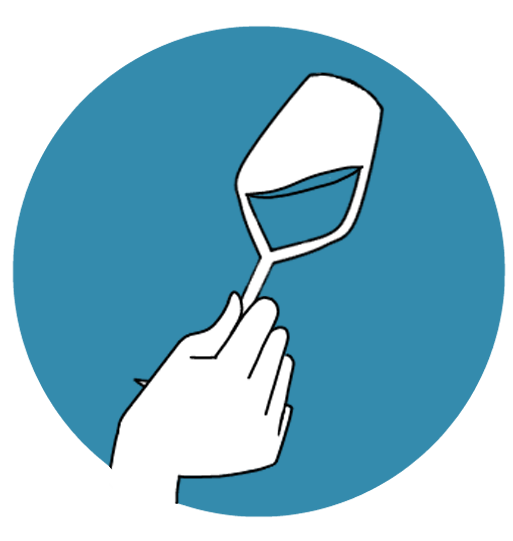
by Wine Owners
Posted on 2019-03-07
In terms of reputation Screaming Eagle is the ne plus ultra of American wines, the equivalent of Petrus on the Right Bank, Romanee-Conti on the Cote de Nuits and Conterno Monfortino in Piedmont.
The prices of the wine varies from £2240 per bottles up to £2600 per bottle for the vintages of 2009, 2011, 2012, 2013 and 2014, but over the last two years it has been the 2009 and 2011 that have made the greatest gains, with 37.9% and 42.7% respectively. Double digt growth seems to be the norm on a CAGR basis.
The 100 point vintages of 2010 and 2007 are roughly £3600 per bottle, and have gown at a slower rate in the last two years, suggesting again that there is better vakue to be had in the 97 to 99 point bracket currently.
Current market levels puts the 97 point ’09 at £2602 a bottle and the 94 point ‘11 at £2461 per bottle. These prices are at a premium of £350 and £200 respectively to the 97 point 2013 and 98 point 2014, which would seem a little illogical. Hard to see a justification for a discount for equivalently scored wines. As the chart below shows, the 2011 in particular seems over-priced and the more recent vintages would seem to offer greater upside potential.
Trying to compare Screaming Eagles with other US wines is a rather thankless task as it operates on a different pricing level entirely to every other wine in California. There are several things you can say about it in isolation, however:
- There is no vintage values at less than £2000 a bottle, and many tip the scales at over £3500 per bottle
- Three pack OWCs are the norm – almost all stock available comes in this format
- It has the highest average Parker score over the last twenty years of any wine in the world except Conterno Monfortino
- No more than 700 cases (12 pack equivalent) are made in any vintage.
It would seem logical to suggest for the medium to long term that younger, higher point scoring vintages offer the greatest potential for capital growth. Not for the faint hearted, of course, but the fundamentals of extremely small production, a style that will see each vintage improve for a minimum of 25 years form bottling and a brand that has cemented itself as the epitome of great modern Californian wine making make this a wine that needs to be considered very seriously as an unavoidable component in any top drawer cellar…

